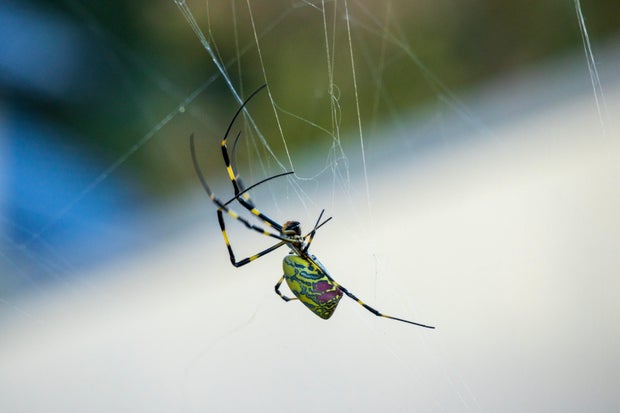Those aren’t early Halloween decorations: giant Joro spiders, known for parachuting through the air, were spotted in Pennsylvania this month.
Six of the spiders were reported on Sept. 5, according to Joro Watch, an interactive monitoring program developed by the University of Georgia’s Center for Invasive Species and Ecosystem Health. An entomologist visited Pennsylvania’s Bucks County and verified there were adult Joro spiders there.
What are Joro spiders?
Joro spiders, which are an invasive species native to Asia, can shoot out long strands of silk that get caught by the wind, carrying them through the air. Some have called them parachuting spiders because of the way they move.
They create large webs that can be up to 10 feet wide, according to PennState Extension.
David Madison / Getty Images
Adult females are large and brightly colored, with legs up to 4 inches long, according to experts. Males are much smaller. While female Joro spiders are about an inch long, male Joro spiders have a body length of less than half an inch.
Female Joro spiders, known for their yellow and gray abdomens, will lay egg sacs holding 400 to 500 eggs.
The spread of Joro spiders — where are they headed?
Joro spiders were first found in the U.S. in Georgia in 2014, but experts believe that the invasive species may have arrived as early as 2010. Joro spiders have spread across the South in the years since. They’ve now been reported across more than half a dozen states.
In 2022, PennState Extension said that it was likely Joro spiders “will be able to spread throughout eastern North America at least as far north as Pennsylvania and possibly further in warmer, coastal areas.” Researchers there thought it may take 35 years for Joro spiders to reach southeastern Pennsylvania, but said there were two ways Joro spiders could reach Pennsylvania more quickly.
One was if young and small Joro spiders were transported tens to hundreds of miles through the air after being picked up by strong winds and storms. The other way would be if they were transported to new areas by humans.
José R. Ramírez-Garofalo, an ecologist at Rutgers University’s Lockwood Lab and the president of Protectors of Pine Oak Woods on Staten Island, in April told SI Live that “it is a matter of when, not if” the spiders arrive in New York and New Jersey.
Are Joro spiders dangerous?
While Joro spiders do have venom, their venom is weak. They also have small fangs, which makes it difficult to pierce human skin.
“We have no evidence that they’ve done any damage to a person or a pet,” Clemson University assistant professor Dave Coyle, who has a doctorate in entomology, previously said.
If a bite does happen, PennState Extension said that it’s less painful than a bee sting, and any localized pain and redness would quickly resolve.
Source link
